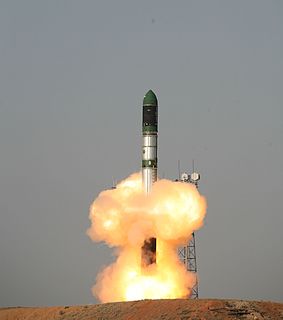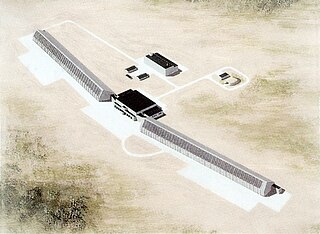Dnepr may refer to:
VD may refer to:

The Dnieper or Dnipro is one of the major transboundary rivers of Europe, rising in the Valdai Hills near Smolensk, Russia, before flowing through Belarus and Ukraine to the Black Sea. It is the longest river of Ukraine and Belarus and the fourth-longest river in Europe, after the Volga, Danube, and Ural rivers. It is approximately 2,200 km (1,400 mi) long, with a drainage basin of 504,000 square kilometres (195,000 sq mi).
Dnieper is a major river, rising in Russia and flowing through Belarus and Ukraine to the Black Sea.

The Desna is a river in Russia and Ukraine, a major left-tributary of the Dnieper. Its name means "right hand" in the Old East Slavic language. It has a length of 1,130 km (702 mi), and its drainage basin covers 88,900 km2 (34,324 sq mi).

The Dnepr rocket was a space launch vehicle named after the Dnieper River. It was a converted ICBM used for launching artificial satellites into orbit, operated by launch service provider ISC Kosmotras. The first launch, on April 21, 1999, successfully placed UoSAT-12, a 350 kg demonstration mini-satellite, into a 650 km circular Low Earth orbit.
Dnipro is a city in Ukraine.

The Battle of the Dnieper was a military campaign that took place in 1943 in Ukraine on the Eastern Front of World War II. One of the largest operations of the war, it involved almost 4,000,000 troops at a time stretched on a 1,400 kilometres (870 mi) front. Over four months, the eastern bank of the Dnieper was recovered from German forces by five of the Red Army's fronts, which conducted several assault river crossings to establish several lodgements on the western bank. Kiev was later liberated in the Battle of Kiev.

The Russian Space Forces are a branch of the Russian Aerospace Forces, that provides aerospace warning, air and space sovereignty, and other related protection for Russia. Having been reestablished following August 1, 2015 merger between the Russian Air Force and the Russian Aerospace Defence Forces after the independent arm of service was dissolved in 2011.

CryoSat-2 is a European Space Agency (ESA) Earth Explorer Mission that launched on April 8th 2010. CryoSat-2 is dedicated to measuring polar sea ice thickness and monitoring changes in ice sheets. Its primary objective is to measure the thinning of Arctic sea ice, but has applications to other regions and scientific purposes, such as Antarctica and oceanography.
Joint CIS Air Defense System is a unified system that comprises air defense units and elements of the former Soviet republics under control of the Coordination Committee on Air Defense of the Council of Ministers of Defense of the CIS. Currently there are 6 de facto members of JADS: Armenia, Belarus, Kazakhstan, Kyrgyzstan, Russia and Tajikistan. 70% of all expenditures of the military budget of the Commonwealth of Independent States are directed to the improvement and development of this system.

Voronezh radars are the current generation of Russian early-warning radar, providing long distance monitoring of airspace against ballistic missile attack and aircraft monitoring. The first radar, in Lekhtusi near St Petersburg, became operational in 2009. There is a plan to replace older radars with the Voronezh by 2020.

Dnestr radar and Dnepr radar, both known by the NATO reporting name Hen House are the first generation of Soviet space surveillance and early warning radars. Six radars of this type were built around the periphery of the Soviet Union starting in the 1960s to provide ballistic missile warnings for attacks from different directions. They were the primary Soviet early warning radars for much of the later Cold War. In common with other Soviet and Russian early warning radars they are named after rivers, the Dnestr and the Dnepr.

Mishelevka Radar Station is the site of three generations of Soviet and Russian early warning radars. It is located in Irkutsk in Siberia and provides coverage of China and missile launches from submarines in the Pacific Ocean. There have been seven radars at this site and it is run by the Russian Aerospace Defence Forces. In 2012 a new Voronezh-M radar is being built at the site.

Balkhash Radar Station is the site of two generations of Soviet and Russian early warning radars. It is located on the west coast of Lake Balkhash near Sary Shagan test site in Kazakhstan. Although it was used for monitoring satellites in low Earth orbit it was mainly a key part of the Russian system of warning against missile attack. It provided coverage of western and central China, India, Pakistan and submarine missile launches in the Bay of Bengal. There have been six radars at this site, the last one was removed from service on 1 June 2020, and it was run by the Russian Aerospace Defence Forces.

Olenegorsk Radar Station is the site of a Soviet and Russian early warning radar. It is located near Olenegorsk on the Kola Peninsula, north of the Arctic Circle in north west Russia. It is considered to be a key part of the Russian early warning system against ballistic missile attack, and provides coverage of ballistic missile launches in the Norwegian Sea and North Sea. The station is operated by the Russian Aerospace Defence Forces.

Sevastopol radar station was a Soviet radar station providing early warning of ballistic missile attack. It is located between the Cape of Chersones and the auxiliary airfield "Chersones" in Sevastopol and was part of the Soviet missile attack warning system. Information from this station could be used for a launch on warning nuclear missile attack or to engage the A-135 anti-ballistic missile system.

Dniprovsko Orilskyi Nature Reserve is a strict nature reserve of Ukraine located in the center of the country in the valley of the Dnieper River. Administratively, the reserve is located in Dnipro Raion of Dnipropetrovsk Oblast, Ukraine.

Shipka is a small military base near the city of Mukachevo in Ukraine. In the past it was a Soviet base that served the Soviet-installed Dnepr radar. In 1992 it was rented to Russia for 15 years. In 2009 the base stopped transferring data to Russia because the Russian authorities refused to continue paying for land lease which was increased in 2006. Formally, in 2008 Russia denounced the Russia-Ukraine agreement about rocket warning systems.

Red Sunset on the Dnieper is an early 20th-century painting by Arkhip Kuindzhi. Done in oil on canvas, the painting depicts a sunset in the sky above the Dnieper river. Sunset is typical of Kuindzhi's style, as he was known for his large landscapes, and can be described as a unique work of Russian luminism—a style of art not widely embraced in Russia. Kuindzhi made two sketches preceding his painting of Sunset.